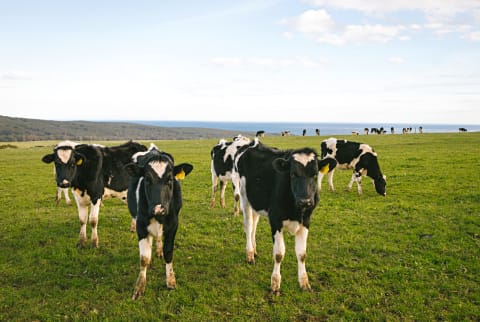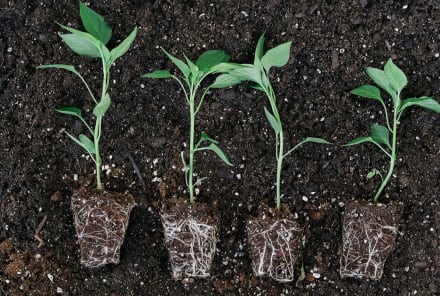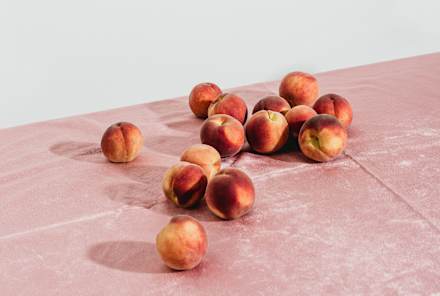Advertisement
How Seaweed Could Reduce Cow's Methane Emissions By Up To 90%


Scan any list of the most polluting industries in the world, and animal agriculture probably ranks near the top. While this is partially thanks to the resources it takes to feed livestock and maintain pasture, the animals themselves can also be significant emitters.
As cows and other grazing ruminants digest their food, their unique, microbe-rich stomachs produce an abundance of methane, which then needs to be released—often in the form of lots and lots of burps.
Once in the environment, this methane is a powerful greenhouse gas that has 25 to 80 times the warming potential of carbon dioxide. According to a report the U.S. EPA released in 20211, this natural process is responsible for more methane than any other source—up to 27.1% of our total emissions.
Now that we know the dangers of cattle digestion, some scientists and farmers are searching for ways to make it smoother for the sake of the planet. And they may have just found their answer, sitting under the sea.
The methane-reducing potential of seaweed supplements
Asparagopsis Taxiformis2, a delicate red seaweed native to tropical waters around the world, first caught the attention of livestock scientists a few years ago. This particular type of seaweed is rich in bioactive compounds that inhibit stomach microbes from forming methane, making it a potentially beneficial feed additive for gassy cows.
Ermias Kebreab, Ph.D., a professor at U.C.–Davis Department of Animal Science, is one researcher who has been putting the seaweed to the test in the lab. After his first live animal feeding trial, he was surprised to find that a few weeks of sprinkling this additive into cows' feed could reduce their emissions by up to 67%3.
During a recent talk at TED Countdown, a summit that gathered industry leaders over climate solutions, Kebreab told the audience that at first, he thought these results were too good to be true. But after repeating the feeding trial in the lab again, this time for nearly a year, the numbers only become more compelling.
And in another trial out of Australia4, the seaweed led to a 98.9% reduction in methane emissions. "That kind of reduction," Kebreab told an excited crowd, "is simply staggering." (Other livestock supplements that have been tested from garlic, citrus, and lemongrass usually cut emissions by around 30% on average.)
Since the seaweed is so concentrated, it doesn't take much of it—less than 1% of feed5—to get these impressive benefits. At such a low volume, the additive doesn't seem to harm the cows in any way or affect the taste of the resulting meat or dairy. "It's a win for the environment, it's a win for the farmers, and the consumers," Kebreab said.
But these findings all came out of a lab—can they actually hold up on the farm? According to new research on cows at Straus Family Creamery in Marin County, the first commercial trial in the United States, the answer is a resounding yes. Not only did 24 dairy cows eat up the red seaweed supplement, but they also reduced their methane emissions by an average of 52%—and as much as 90%—in the process.
The next stop for this promising climate solution could be your local meat counter, but first, we just need to figure out how to grow it fast enough.
Growing a new future feed
All of the trials that have been done thus far have used wild-harvested seaweed, which, according to Jennifer Smith, Ph.D., a coastal ecologist, "is not a sustainable solution to this industry."
Smith, who works as a scientific adviser for Blue Ocean Barns, the seaweed-supplement maker behind that Straus Creamery trial, explains to mbg that there isn't enough of this species in the wild to feed the one billion-plus cows on our planet.
Her team is now working on growing it in captivity. They hope that a combination of land-based seaweed farms—think rows of long, clear cylindrical tanks where the superfood can grow quickly—and sustainably managed open-ocean farms can provide us with enough Asparagopsis Taxiformis to go around.
"With the momentum and excitement behind this potential industry, there's an urgent need to figure out how to grow it as fast as we can to supply as many livestock as we can," Smith says. Next up, Blue Ocean Barns and Straus will try to give this aquaculture-grown seaweed to cows for the first time. Pending positive results from that research, they can go ahead with rolling out their new model for seaweed farming as quickly as possible.
It will be a challenge, to be sure: Smith reminds me that new agriculture industries don't just emerge overnight, and this particular seaweed can be very finicky to grow. But in time, it could feed the growing movement of ocean farmers in the U.S.
At this point, you might be wondering why we're putting resources into making beef and dairy more sustainable at all, instead of just encouraging people to eat plant-based. While Kebreab acknowledges that going vegan or vegetarian is a good way to reduce your carbon footprint (and in many cases, improve your health) if you live in a high-income country, the same can't be said for those in the developing world.
Originally from Eritrea, a country in northeast Africa, Kebreab has seen firsthand how essential beef and milk are for delivering essential nutrients like B12 and vitamin A in people who are otherwise deficient and at risk of stunting, vision problems, and other nutritional deficiencies.
If richer countries like the U.S. can put resources into developing simple, scalable climate solutions like this one, it would allow people around the world to continue getting the nutritional benefits of meat—without the side of methane.
The demand for such solutions has never been stronger. Case in point: Methane is at the top of the agenda at COP26, the most important global climate conference in years. So far at COP, more than 105 nations have pledged to work together to reduce global methane emissions by 30% over 2020 levels by 2030. In the race to keep emissions in check and warming down, methane will undoubtedly need to be part of the equation. And in the race to get methane under control, seaweed is one unlikely climate solution that could really make waves.
5 Sources
- https://www.epa.gov/sites/default/files/2021-04/documents/us-ghg-inventory-2021-main-text.pdf?VersionId=yu89kg1O2qP754CdR8Qmyn4RRWc5iodZ
- https://www.ncbi.nlm.nih.gov/labs/pmc/articles/PMC7968649/
- https://www.sciencedirect.com/science/article/abs/pii/S0959652619321559?via%3Dihub
- https://pubmed.ncbi.nlm.nih.gov/24465524/
- https://journals.plos.org/plosone/article?id=10.1371/journal.pone.0247820#pone.0247820.ref026











